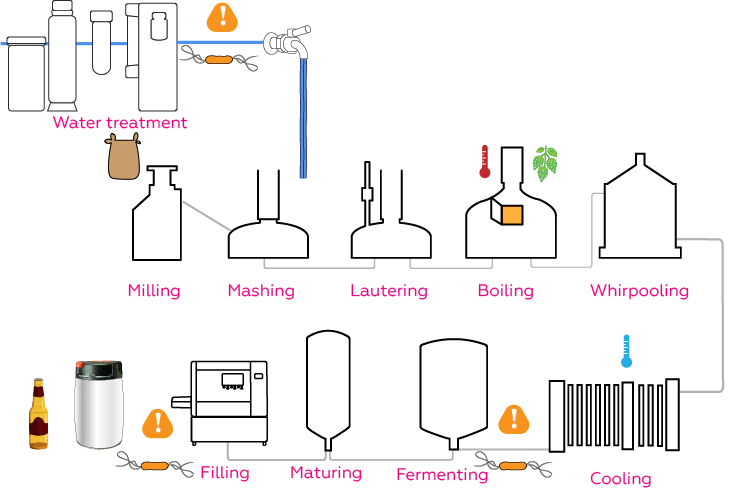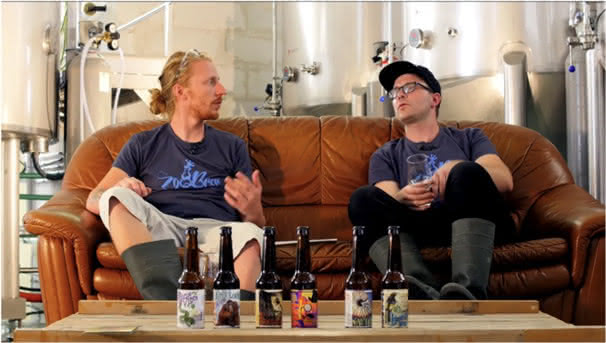Starting a microbrewery is an exciting journey. You start everything from the beginning, join a community of passionate brewers, test, learn, and improve the quality of your beer. When your beer gains in popularity and is « exported » at some distance from the brewery, you’re starting to face new challenges.
As you need to ensure a constant beer’s quality, you need to manage different parameters. One parameter is critical if you to take a step further: Controlling microbiology to ensure beer’s quality.
What is beer quality?
There are many aspects to consider as beer quality is measured by a complex set of sensory characters. These indicators are aroma, taste, texture, and appearance.
Together, they defined a sensory profile specific to your brand; this is what makes your beer unique. Preserving this quality at every sip builds your brand loyalty; it keeps your consumers excited about your craft beer.
Dealing with a growing expectation for your craft beer
When production volumes increase, so does the expectation for a reproducible taste. Your consumers love your product and expect the same quality every time. Whether it is from a bottle or at the bar, they want to enjoy the same taste, texture, aroma, and appearance.
As your facility grows, so do the risks of microbial issues that can alter your beer’s quality. Good brewing practices are available for large breweries, expressed in modern Quality Assurance terms, in documents approaching the subject from the HACCP or Hygiene monitoring perspective. As a still small brewery, where can microbiology impact the quality of your beer?
Microbiological contamination by wild yeasts, molds, and a wide variety of bacterial species can deteriorate the quality of your beer. It can cause off-flavors, souring of beer, over carbonation, the eruption of beer from bottles, and serious hazes.
8 stages where microbiology can impact your beer’s quality

Microorganisms are everywhere, and a brewery working with yeast in a humid environment is the perfect place for microbial contamination. Beer provides nutrients for many undesirable organisms. Where should you start looking for preventing microbial contamination?
1. Barley, Malt, Grits
In the field, a vast variety of bacteria and fungi are present on the barley. Grinding, grit storage exposes the material to contamination by the environment, stimulated by humidity (condensation) and warmth.
Potential flora: Fusarium, Lactobacillus, ..
Impact: some mycotoxins survive the brewing process and can inhibit yeast growth during brewing, cause premature yeast flocculation, beer gushing/over foaming…
Prevention: store dry and low temperature,
2. Water
For brewers, water is indispensable for many things, among which is used as a raw material.
Drinking water contains residual chlorine to prevent bacterial growth in the distribution piping. Treatments to remove scale, unwanted organic matter, and chlorine also removes this protection. Some treatment steps, such as carbon filtration or softeners, can promote the development of microorganisms.
Potential flora: Pseudomonads, Enterobacteria, Cladosporidium,..
Impact: biofilm formation upstream in the process, which contaminates downstream
Prevention: appropriate water treatment system design, techniques and maintenance, short storage, storage at low or high temperature to limit bacterial proliferation
3.Lines, fittings, holding tanks, …
Anything in contact with the product during the process is susceptible of affecting the product: condensation, incomplete draining, solid material caught on an inner asperity such as couplings can stimulate microbial growth.
Potential flora, from water, brewing material and environment: Lactic-acetic bacteria, enterobaceriaceae, Gluconobacter,..
Impact: production of Acetaldehydes, diacetyl, ..
Prevention : components should be clean, undamaged and sterilized
4. Heat exchangers
The nutrient-rich wort leaving the kettle is vulnerable to spoilage organisms. Heat exchangers are challenging to clean because of their large internal surface and the tortuous channels the wort passes through. The retained organic material in a humid environment is favorable to the proliferation of microorganisms.
Potential flora: Enterobacteria, Lactobacilli, Pediococci, Yeasts
Impact: production of unpleasant flavors, inhibition of Saccharomyces growth
Prevention: proper cleaning and sanitation – rapid fermentation after cooling
5. Beer
Once Saccharomyces and hop are added to the wort, conditions become hostile to most microorganisms. However, when the beer is exposed to environmental contamination, some microorganisms can grow.
Potential flora: Hop-Resistant Lactobacilli, Pediococci, Acetic acid bacteria, Zymomonas (if adjunct sugar)
Impact: acidification, haze, unpleasant aroma
Prevention: Good hygiene practices upstream, limited exposure to the environment and to oxygen
6. Bottling equipment
Bottling is the last process step after which the live microbes escape the brewers’ control. Controlling the sanitary status of that equipment means lowering the risk of undesirable fluctuations in beer stability.
Potential flora: the panoply described above, forming biofilms
Impact: shortened microbial stability
Prevention: proper cleaning and sanitation
7. Transportation and storage
It doesn’t end when your beer leaves your facility! Beer storage areas should be free of food to prevent the growth of microorganisms that could spoil and alter your product.
Potential flora: Pectinatus spp, Megasphaera
Impact: Haze, Off-flavors
Prevention: limit exposure to temperature changes, light and turbulence
8. In bars
When customers ask for your beer at their local bar, they expect the same quality. To ensure a high-quality beer, bar drains should be clean and flushed free of waste beer frequently. It helps prevent microbial growth and fruit flies.
Potential flora : Acetic bacteria, Lactobacilli, Pediococci,..
Impact: Haze, Off-flavors
Prevention: clean faucets, proper serving techniques
How can you start controlling your beer’s quality?
What gets measured gets managed. To ensure high-quality beer and prevent microbial spoilage, maintain audit regularly, and report your results.
Most of the controls conducted in industrial breweries require a laboratory and some expertise, not always available to small entities. Outsourcing these tests, on the other hand, does not offer the required reactivity and flexibility.
Once a plan of control is established, we believe that every worker in a brewery should be able to control and prevent microbial contamination. That’s why we created BioMire.
Controlling and monitoring microbial activity easily anywhere and at any time could help artisans, managers, and entrepreneurs make high-quality products. With our nomad On-Site Microbial Test Kits, you can start monitoring easily and get quantitative results.
We hope that these insights will help on your journey. Start measuring microbiology is not as difficult as it seems and can lead to tremendous results. For more information on how to measure microbial activity to maintain your beer’s quality, you can subscribe to our mailing list or directly get in touch with us.

Further reading: The microbiology of Malting and Brewing – Nicholas A. Bokulich, Charles W. Bamfortha ; Best Practices Guide to Quality Craft Beer – Brewers Association

